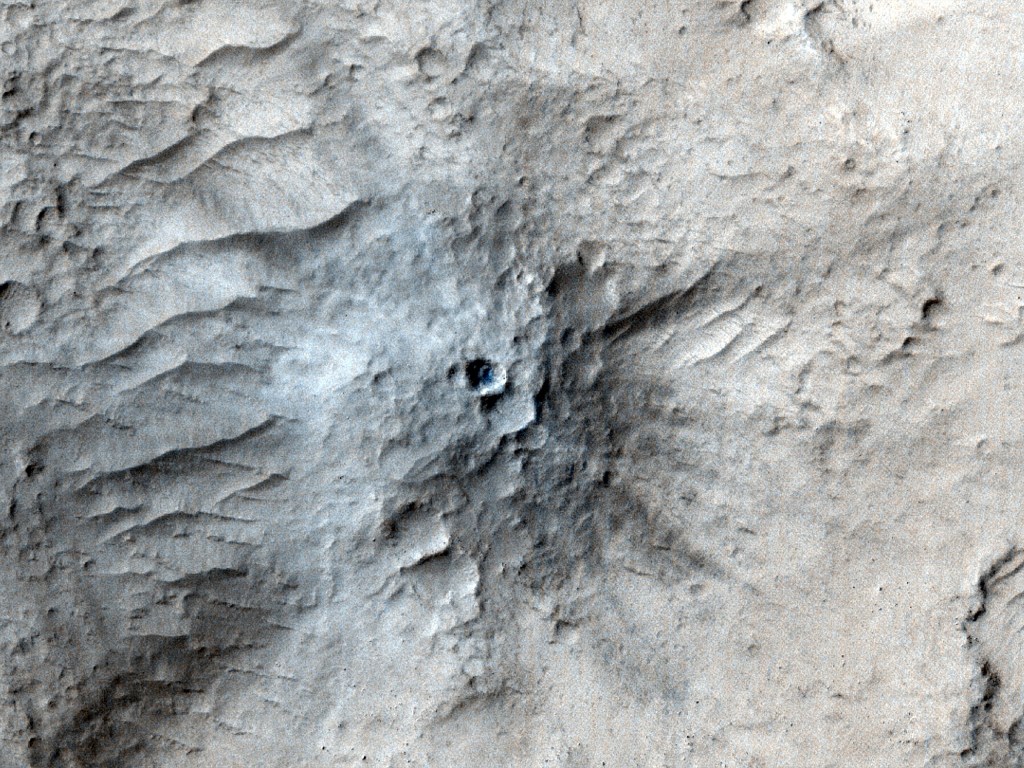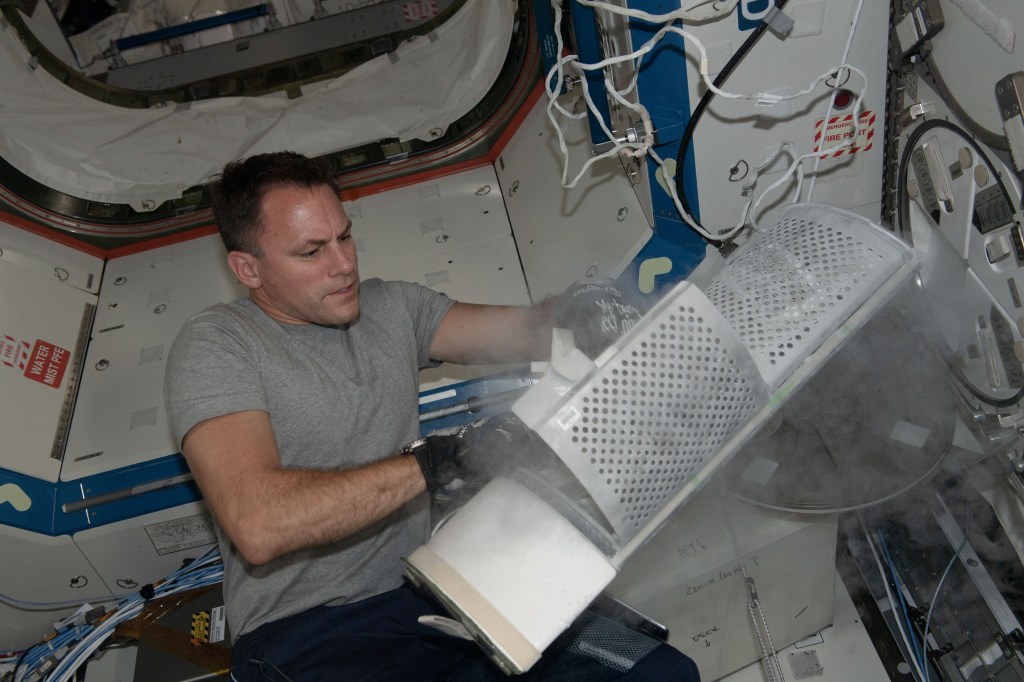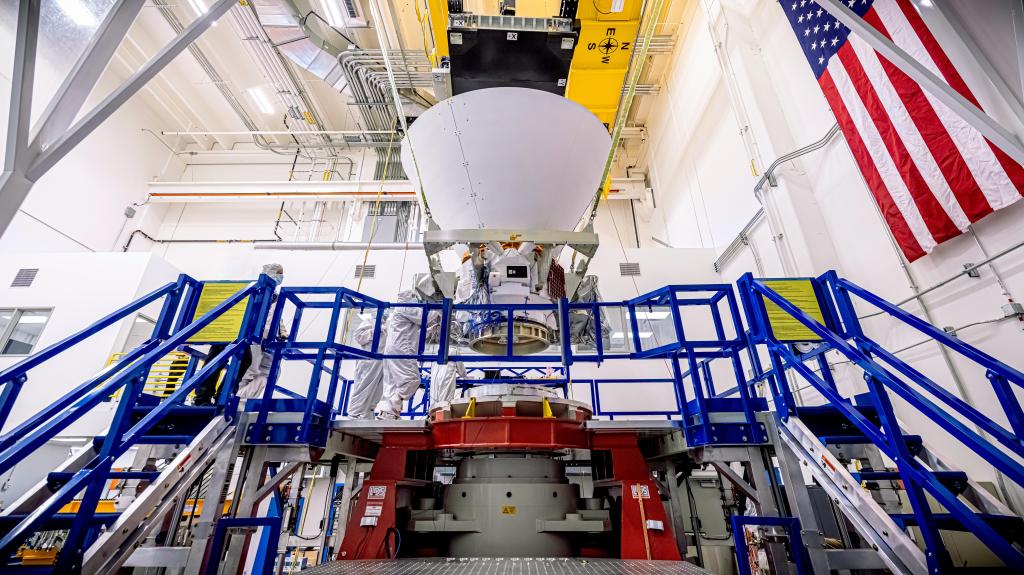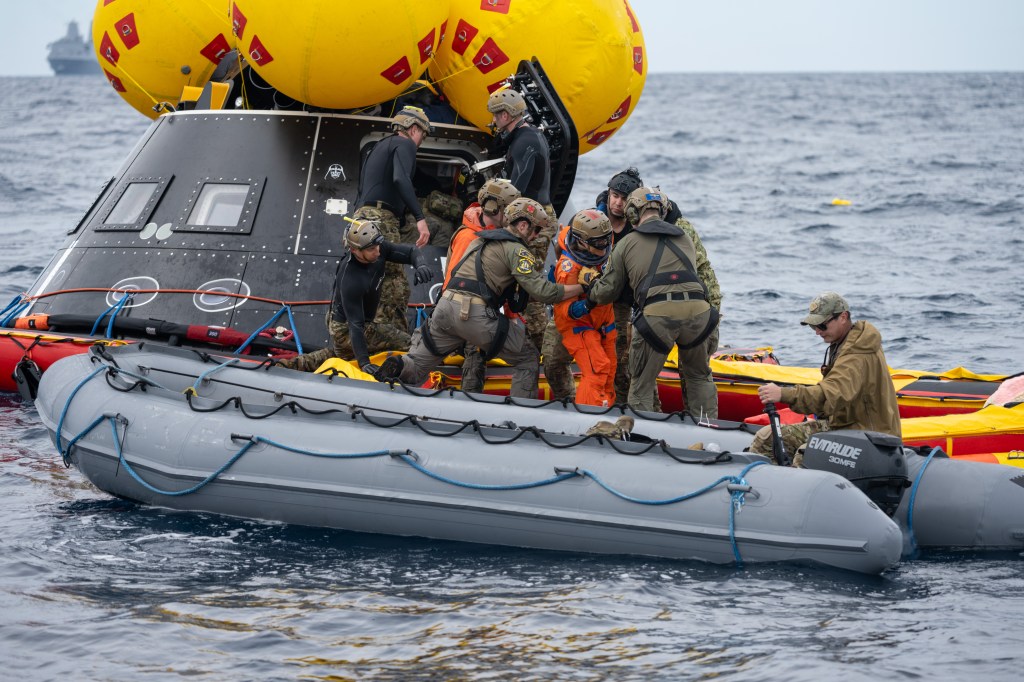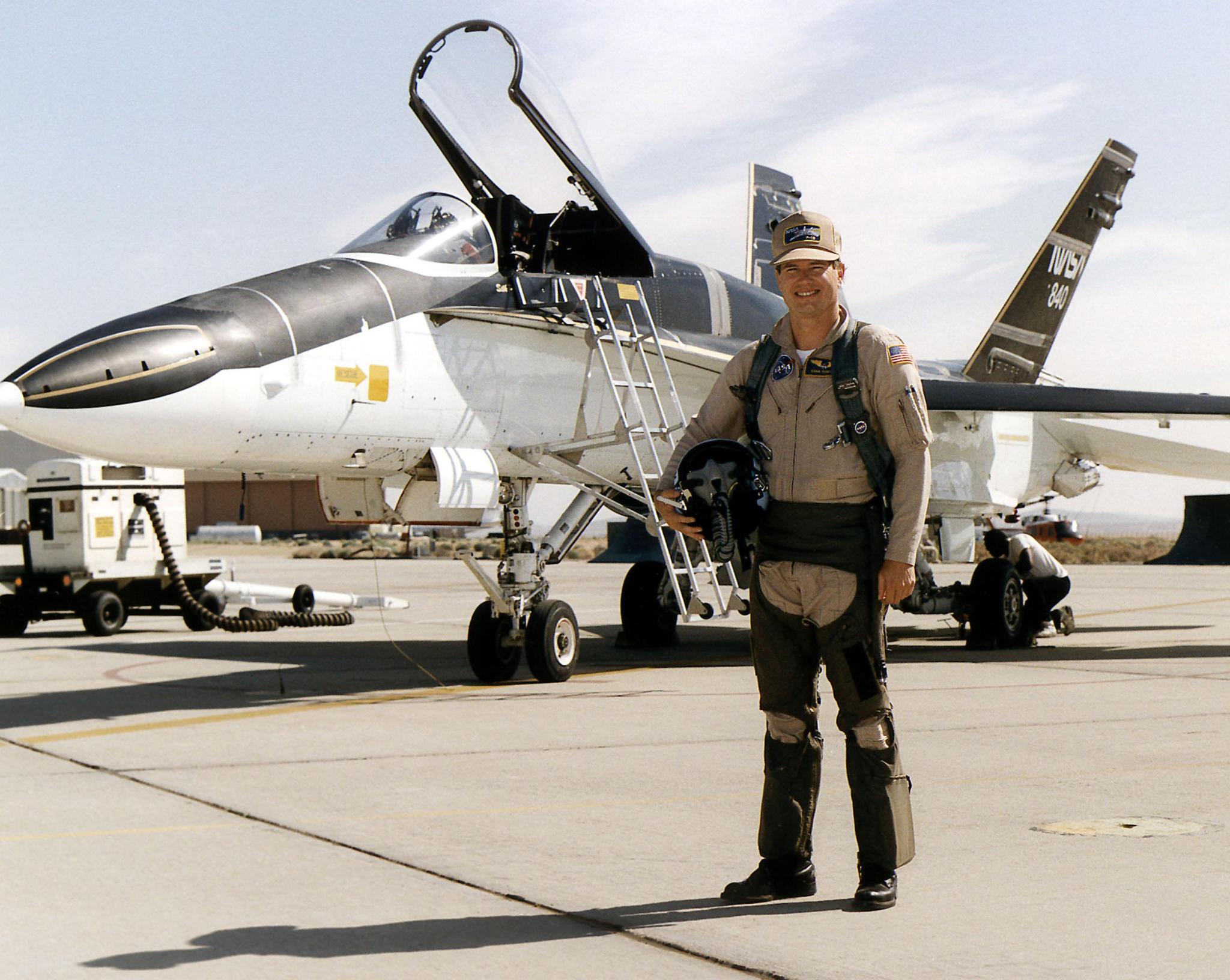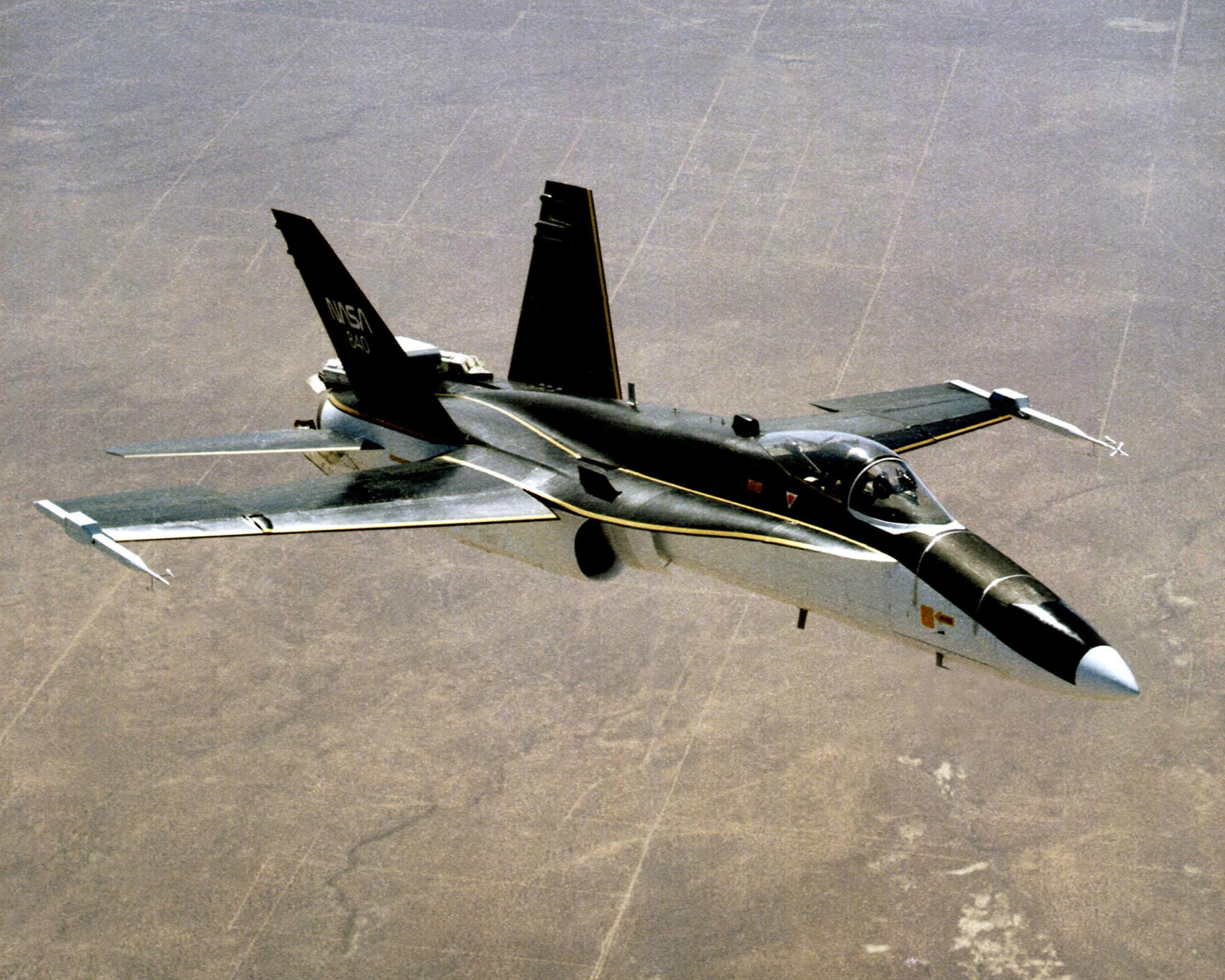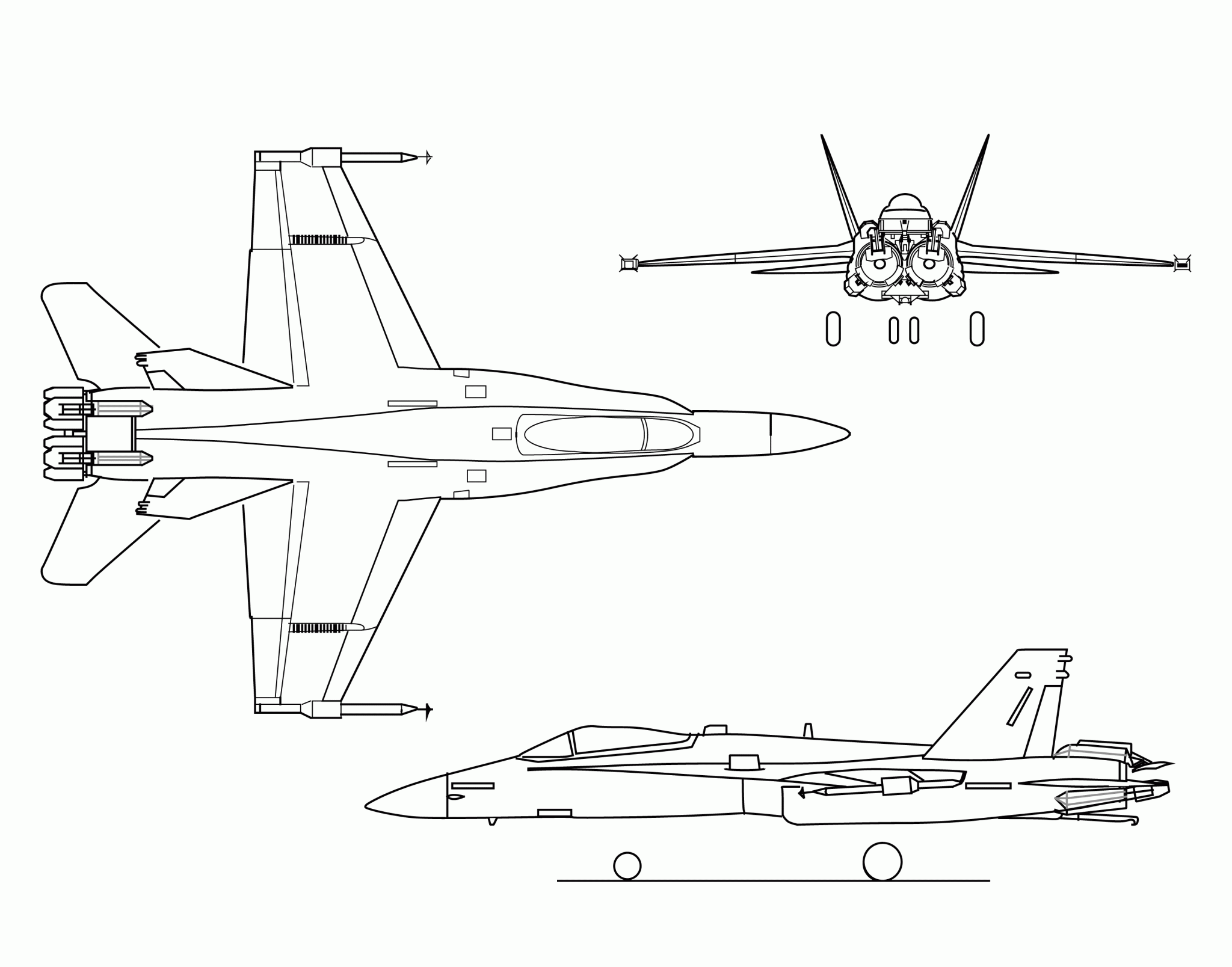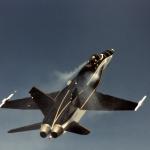F-18 High Alpha Research Vehicle (HARV)

NASA’s Dryden (now Armstrong) Flight Research Center in Edwards, California, used an F-18 Hornet fighter aircraft as its High Angle-of-Attack (Alpha) Research Vehicle (HARV) in a three-phased flight research project lasting from April 1987 until September 1996. The aircraft completed 385 research flights and demonstrated stabilized flight at angles of attack between 65 and 70 degrees using thrust vectoring vanes, a research flight control system, and (eventually) forebody strakes (hinged structures on the forward side of the fuselage to provide control by interacting with vortices, generated at high angles of attack, to create side forces).
This combination of technologies provided carefree handling of a fighter aircraft in a part of the flight regime that was otherwise very dangerous. Flight research with the HARV increased our understanding of flight at high angles of attack, enabling designers of U.S. fighter aircraft to design airplanes that will fly safely in portions of the flight envelope that pilots previously had to avoid.
Background
Angle of attack (alpha) is an aeronautical term that describes the angle of an aircraft’s body and wings relative to its actual flight path. During maneuvers, pilots often fly at extreme angles of attack with the nose pitched up while the aircraft continues in its original direction. This can lead to conditions in which the airflow becomes separated over large regions of the lifting surfaces (airfoils). This can result in insufficient lift to maintain altitude or control of the aircraft and a corresponding increase in drag a condition known as stall. (In an ideal situation, the airflow would remain attached to the airfoil surface from leading to trailing edge; this would reduce the drag that impedes the movement of the airfoil through the atmosphere. When the airflow separates from the surface, this increases the drag and can lead to a stall.)
About 1985, NASA began a formal program to explore and understand aircraft flight at high angles of attack, although the agency has always been interested the subject. NASA’s Langley Research Center in Hampton, VA., managed this High Angle-of-Attack Technology Program (HATP) in partnership with Ames Research Center at Moffett Field, CA; Dryden Flight Research Center (a name it regained in 1994); and Lewis Research Center (now Glenn Research Center) Cleveland, OH. Besides managing the project, Langley performed subscale wind-tunnel testing, advanced control law synthesis, and computational fluid dynamics (CFD use of computers to predict aerodynamic behavior). Ames contributed further CFD work and its 80- by 120-foot wind tunnel. Lewis worked on inlet and engine integration. Dryden performed the flight research. Other partners came from industry, academia, and the Department of Defense (U.S. Navy, U.S. Air Force, and U.S. Marine Corps) plus some NATO participants. Between 1990 and 1996, NASA was the host for conferences every two years dealing with high angle-of-attack research and technology.
The NASA HATP has produced technical data from actual flight at high angles of attack to validate computer codes (CFD) and wind tunnel research. Successful validation of these data has given engineers and aircraft designers a better understanding of aerodynamics, effectiveness of flight controls, and airflow phenomena at high angles of attack. Motivated by the tactical advantages of enhanced high angle-of-attack agility and maneuverability, they have used this understanding to design features providing better control and maneuverability in future high performance aircraft that will make them safer to fly. This is partially exemplified in designs already implemented in the F-22 Advanced Tactical Fighter and prototypes of the Joint Strike Fighter. Thrust vectoring research also continued at Dryden with the Enhanced Fighter Maneuverability X-31 and the F-15 Advanced Controls Technology for Integrated Vehicles (ACTIVE) research aircraft. These research efforts led to revolutionary technological leaps in design tools and to increased confidence resulting from actually flying experimental aircraft at high angles of attack or under supersonic cruise conditions.
The primary objectives of HATP were to provide flight-validated aircraft design tools and to improve the maneuverability of aircraft at high angles of attack. The program has placed particular emphasis on the areas of aerodynamics, propulsion, control law research, and handling qualities. To this end, project personnel determined that full-scale flight research was essential to address the inherent shortcomings of subscale model testing in wind tunnels and CFD. The aircraft NASA selected for a large part of this flight research was a McDonnell Douglas F-18, which became known as the F-18 HARV after it was rebuilt and modified for HATP. The F-18 was an exceptionally fine high angle-of-attack aircraft in its production form. It had no angle-of-attack restrictions at normal center-of-gravity positions. It was this characteristic that made it NASA’s choice as a research vehicle.
Phase One
The first phase of “high alpha” flights began in April 1987 and lasted through 1989. It consisted of 101 research flights in the specially instrumented F-18 at angles of attack as high as 55 degrees. During this phase, there were no external modifications to the aircraft, but technicians equipped it with extensive instrumentation. NASA research pilot Einar Enevoldson made the first (functional check) flight on April 2, 1987, and three succeeding flights before turning the piloting duties over to NASA research pilots Bill Dana and Ed Schneider. The purpose of this phase was to obtain experience with aerodynamic measurements at high angles of attack and to develop the flight research techniques needed for this measurement.
Researchers conducted visual studies of the airflow over various parts of the aircraft. Special tracer smoke was released through small ports just forward of the leading edge extensions near the nose; on-board video and still cameras captured images of the smoke as it followed airflow patterns around the aircraft. Also photographed in the airflow were short pieces of yarn (tufts) taped on the aircraft and anti-freeze with dye in it, released onto the aircraft surfaces from hundreds of small orifices around the vehicle’s nose.
Researchers used the film and videotape images of the airflow patterns from the smoke, dye, and tufts for a comparison with computer and wind tunnel predictions. Additional data that they obtained included air pressures recorded by sensors located in a 360-degree pattern around the nose and at other locations on the aircraft. Researchers paid particular attention to the location of strong vortices (masses of air in circular motion) that formed off the forebody and wing-body-strake (leading-edge extension or LEX) at high angles of attack and their role in inducing tail buffeting (beating by unsteady flow, gusts, etc.).
Phase Two
Phase Two flights examined the benefits of using vectored thrust to achieve greater maneuverability and control at high angles of attack while continuing the correlation of flight data with wind-tunnel and computational fluid dynamics (CFD) data begun in Phase One. The initial portion of the Phase Two flight program was completed in January 1993.
Phase Two featured major hardware and software modifications to the HARV – a multiaxis thrust-vectoring control system featuring vanes attached to the aft end of the aircraft and a research flight control system. Three paddle-like vanes, made of Inconel®1 metal (a nickel alloy containing chromium and iron that is heat resistant), were mounted around each engine’s exhaust. They provided both pitch (up and down) and yaw (right and left) forces to enhance maneuverability when the aerodynamic controls were either unusable or less effective than desired. The engines had the divergent portion of the exhaust nozzles removed to shorten the distance the vanes had to be cantilevered by about two feet. The subsonic performance of the engines, including afterburning, was largely unaffected by the modifications, but supersonic flight was no longer possible – a penalty unique to this experimental project. The thrust vectoring control system added 2,200 pounds to the total weight of the aircraft. In addition, the inclusion of a spin parachute for safety plus an emergency power system and ballast added a further weight penalty of 1,500 pounds. The HARV also carried 419 pounds of other equipment and wiring not directly associated with the thrust-vector-control system.
The research flights began in July 1991 using the thrust vectoring system for control. The system could deflect the exhaust flow from the two turbofan engines to provide enhanced maneuverability and control in areas where conventional aerodynamic controls are ineffective. (These controls included ailerons, rudders, stabilators [stabilizers + elevators – all-movable horizontal stabilizers in the tail area], and leading-edge flaps.) The system resulted in significantly increased maneuverability at moderate angles of attack and some degree of control at angles of attack up to roughly 70 degrees. It also allowed researchers to collect a greater amount of data by remaining at high angles of attack longer than they could have done without it.
The modified flight control computers used a PACE 1750A computer and specially written flight control laws to provide the research flight control capability. These laws commanded the optimum combination of aerodynamic control and vectored thrust to satisfy pilot demand. Program engineers integrated all controls into these flight control laws. The pilot used standard cockpit controls and no special pilot action was required after the system was engaged in flight. In addition to the research flight control computers, pilots also used the original F-18 flight control system both as a backup to the research system and to perform take-offs and landings.
Dryden research pilots Bill Dana and Ed Schneider completed the envelope expansion flights in February 1992. Demonstrated capabilities included stable flight at approximately 70 degrees angle of attack (previous maximum was 55 degrees) and rolling at high rates at 65 degrees angle of attack. Controlled rolling would have been nearly impossible above 35 degrees without vectoring.
Between January 1993 and January 1994 the aircraft was modified with a sophisticated engine inlet pressure measurements system between the inlet entrance and the engine face. This information provided unprecedented understanding of what happens to engine airflow under extreme maneuver conditions. Flights resumed in January 1994 and continued through June 1994, with Ed Schneider and Jim Smolka as the Dryden research pilots, joined for short periods by U.S. Navy pilots. In Phase Two there were a total of 193 flights, including some transition flights to Phase Three.
Phase Three
The Phase Three effort began in March 1995 to evaluate moveable strakes on both sides of the aircraft’s nose to provide yaw control at high angles of attack where conventional rudders became ineffective. These strakes, 4 feet long and 6 inches wide, were hinged on one side and mounted to the forward sides of the fuselage. At low angles of attack, they were folded flush against the aircraft skin. At higher angles of attack, they were extended to interact with the strong vortices generated along the nose and thereby produce large side forces for control. Wind tunnel tests indicated strakes could be as effective at high angles of attack as rudders are at lower angles. Flights with active moveable strakes began in July 1995. The availability of the strakes enabled pilots to employ three separate flight modes. One used thrust vectoring alone. Another used thrust vectoring for longitudinal (pitch) control and a blend of thrust vectoring and strakes for lateral (side-to-side) control. A third mode used thrust vectoring solely for longitudinal control, with strakes alone for controlling lateral motion. These three options were a unique feature of the HARV project. They afforded a great deal of flexibility in research into control power requirements at high angles of attack. They were also a means of achieving detailed investigation of handling qualities at high angles of attack.
The strake project concluded in September 1996 with flight 385 of the HARV program. It yielded a great deal of information about the operation of nose strakes, which were effective in providing control above 35 degrees angle of attack. Phase Three included 109 flights. Besides Schneider and Smolka, the research pilots included Mark Stucky from Dryden, Phil Brown from Langley, and a number of guest pilots from the U.S. Navy and Marine Corps, the Canadian Air Force, the (British) Royal Air Force, McDonnell Douglas, CalSpan, and NASA Dryden.
Project Management
As previously mentioned, the high angle of attack technology project was a joint effort of NASA’s four aeronautical Centers. Joe Chambers and Billy Gilbert at Langley started the project. The project managers at Dryden were, successively, Don Gatlin, Jennifer Baer-Riedhart, and Denis Bessette. The project engineers were Bruce Powers, Dave Fisher, John Del Frate, Bob Meyer, Neil Matheny, Vicki Regenie, and Al Bowers. Operations engineers included Art Tanaka, Dick Klein, and Brad Flick. Flight test engineers were Jim Cooper and Mike Muratore. The crew chiefs were Al Grieshaber, John McKay, and Darryl Townsend.
Aircraft Specifications
The HARV was developed from a pre-production model of the F-18, a single-seat fighter aircraft built by the McDonnell Aircraft Co., St. Louis, MO. This particular F-18, built before the redesignation of the aircraft to F/A-18, was borrowed from the U.S. Navy for high angle-of-attack research because it was equipped with a spin chute, having been used by the Navy for spin testing. Bearing Bureau Number 160780, this F-18 was the sixth full-scale developmental F-18 built for the Navy by McDonnell Douglas Corporation (St. Louis, MO). F/A-18s are currently in service with the U.S. Navy and Marine Corps.
The particular F-18 used for the HARV had unfortunately been heavily “cannibalized” (used as a source of spare parts) by the Navy, which never expected the aircraft would fly again. It arrived at Dryden in pieces aboard a semitrailer in October 1984, missing 400 parts and having very little documentation on its existing wiring system. Dryden mechanics and technicians had to find substitute parts, cut out all the existing wiring, then assemble the aircraft and rewire it. When they completed the job, they painted the words “Silk Purse” on the side of the fuselage to indicate what they had made from the “Sow’s Ear” of cannibalized aircraft parts with which they had begun.
The aircraft had a wing span of 37 feet 5 inches. The fuselage was 56 feet long and 10 feet 6 inches high at the canopy.
The HARV was powered by two General Electric F404-GE-400 turbofan engines, each producing 16,000 lb of thrust in afterburner.
The weight of the HARV was 31,980 lb, with 6,480 lb of internal fuel, in the Phase One configuration. It was 36,099 pounds with the same amount of fuel, configured for Phases Two and Three, including the thrust vectoring and spin recovery parachute systems.
The aircraft is on permanent display in the Virginia Air & Space Center, Hampton, Virginia.
Sources
- Flight logs compiled by Joe Wilson and Karen Richards, available in the Dryden Historical Reference Collection.
- Kenneth W. Iliff and Kon-Sheng Charles Wang, “Flight-Determined Subsonic Longitudinal Stability and Control Derivatives of the F-18 High Angle of Attack Research Vehicle (HARV) With Thrust Vectoring,” (Edwards, CA: NASA TP-97-206539, 1997).
- Albion H. Bowers, et al., “An Overview of the NASA F-18 High Alpha Research Vehicle,” (Edwards, CA: NASA TM-4772, 1996).
- David F. Fisher with Daniel G. Murri, “Forebody Flow Visualization on the F-18 HARV With Actuated Forebody Strakes,” (Edwards, CA: NASA TM-1998-206556, 1998).
- Victoria Regenie, Donald Gatlin, and Robert Kempel, “The F-18 High Alpha Research Vehicle: The High-Angle-of-Attack Testbed Aircraft,” paper delivered at the AIAA Biennial Flight Test Conference, August 24-26, Hilton Head Island, SC (AIAA-92-4121).
- David F. Fisher, John H. Del Frate, and David M. Richwine, “In-Flight Flow Visualization Characteristics of the NASA F-18 High Alpha Research Vehicle at High Angles of Attack,” (Edwards, CA: NASA TM 4193, 1990).
1. Inconel is a trade name belonging to Huntington Alloy Products Division, International Nickel Company, Huntington, West Virginia.

